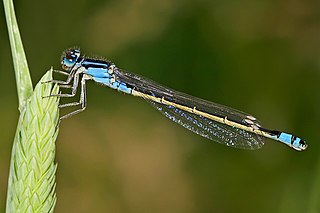
The ferruginous duck, also ferruginous pochard, common white-eye or white-eyed pochard is a medium-sized diving duck from Eurasia. The scientific name is derived from Greek aithuia an unidentified seabird mentioned by authors including Hesychius and Aristotle, and nyrok, the Russian name for a duck.
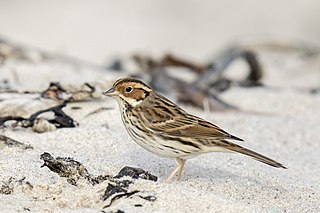
The little bunting is a passerine bird belonging to the bunting and American sparrow family (Emberizidae), a group most modern authors separate from the true finches (Fringillidae).

The red-faced malkoha is a member of the cuckoo order of birds, the Cuculiformes. This malkoha species is endemic to Sri Lanka
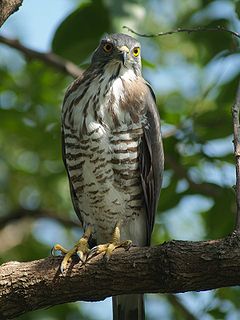
The crested goshawk is a bird of prey from tropical Asia. It is related to other diurnal raptors such as eagles, buzzards and harriers, and thus placed in the family Accipitridae.
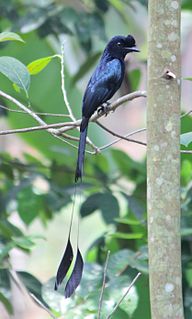
The greater racket-tailed drongo is a medium-sized Asian bird which is distinctive in having elongated outer tail feathers with webbing restricted to the tips. They are placed along with other drongos in the family Dicruridae. They are conspicuous in the forest habitats often perching in the open and by attracting attention with a wide range of loud calls that include perfect imitations of many other birds. One hypothesis suggested is that these vocal imitations may help in the formation of mixed-species foraging flocks, a feature seen in forest bird communities where many insect feeders forage together. These drongos will sometimes steal insect prey caught or disturbed by other foragers in the flock and another idea is that vocal mimicry helps them in diverting the attention of smaller birds to aid their piracy. They are diurnal but are active well before dawn and late at dusk. Owing to their widespread distribution and distinctive regional variation, they have become iconic examples of speciation by isolation and genetic drift.
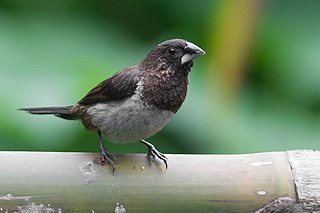
The white-rumped munia or white-rumped mannikin, sometimes called striated finch in aviculture, is a small passerine bird from the family of waxbill "finches" (Estrildidae). These are close relatives of the true finches (Fringillidae) and true sparrows (Passeridae).
The Calayan rail is a flightless bird of the rail, moorhen, and coot family (Rallidae) that inhabits Calayan Island in the Philippines. Though well-known to natives of the island as the "piding", it was first observed by ornithologist Carmela Española in May 2004 and the discovery was officially announced on August 16, 2004. The formal description as a species new to science appeared in the journal Forktail.

The forest owlet is an endangered owl that is endemic to the forests of central India. The species belongs to the typical owls family, Strigidae. First described in 1873, it was not seen after 1884 and considered extinct until it was rediscovered 113 years later in 1997 by Pamela Rasmussen. Searches for the species in the locality given on the label of the last collected specimen failed and it was discovered that the specimen had been stolen from the British Museum by Richard Meinertzhagen and resubmitted with a label bearing false locality information. It is known from a small number of localities and the populations are very low within the fragmented and shrinking forests of central India.

The black-backed forktail, occasionally referred to as the black-throated forktail, is a forktail species in the family Muscicapidae. The species was described in 1836, from a specimen collected in Nepal. It is a medium-sized forktail, weighing between 25 and 29 grams, with a length of 20.5 to 23 centimetres. The species has a broad white stripe across its forehead. The crown, face, and mantle are black, while the bird's underparts are white, sharply divided from the black above. The wings are largely black with a broad white stripe across the greater coverts. The tail of the species, similar to that of other forktails, is long, graduated, and deeply forked. The tail is black with a white tip and three white bands created by shorter tail feathers. The beak of the bird is black, while the feet and legs are light pink, and the iris is brown. The species is monomorphic.

The white-crowned forktail is a species of forktail in the family Muscicapidae. Scientifically described in 1818, it has six subspecies, each occupying a different geographic range. The largest of the forktails, Enicurus leschenaulti, is between 25 and 28 centimetres long. It has a black throat and breast, black mantle, and largely black wings. The rump and lower back are white, and the bird has a prominent white crown, from which it gets its name. As with other forktails, the tail is long, deeply forked, and banded in black and white. A variety of whistling and clicking calls have been described. Slight morphological differences have been observed between subspecies.

The spotted forktail is a species of bird in the family Muscicapidae. It is found in the Himalayas and the hills of Northeast India, Bangladesh, Myanmar, and southern China including Yunnan. Birds of this species are 25 cm with a long tail. The sexes are alike, having a white forehead and a black crown and nape, a black back spotted white, and a broad white wing bar. The tail is deeply forked, graduated black and white. The white spotted back easily identifies this species from other similar sized forktail. Its call is a shrill, screechy KREE, mostly given in flight; it also makes some shrill, squeaky notes while perched. It breeds mostly at 1200–3600 m, and descends to about 600 m in winter. Its natural habitat is subtropical or tropical moist montane forests, where it is found in boulder-strewn torrents, forest streams, and roadside canals.

The chestnut-naped forktail is a species of bird in the flycatcher and chat family Muscicapidae. The species is monotypic, having no subspecies. It is found in Sundaland, in southern Burma and Thailand to Peninsular Malaysia, as well as Sumatra and Borneo. The species is not migratory.

The slaty-backed forktail is a species of forktail in the family Muscicapidae. A slim, medium-sized forktail, it is distinguished from similar species by its slate grey forehead, crown, and mantle. It has a long and deeply forked tail banded in black and white, a white rump, and a white bar across its primary feathers; the rest of the plumage is predominantly white. The sexes look alike. The bird frequents the edges of fast-flowing streams and rivers, where it hunts small invertebrates by hopping among rocks or flying out over the water. It breeds between February and July, laying 3–4 pinkish, bluish, or white eggs; both sexes incubate the eggs.

The little forktail is a species of bird in the family Muscicapidae.

The Sunda forktail is a species of bird in the family Muscicapidae. It is endemic to Indonesia, where it is restricted to the islands of Java and Sumatra. Its natural habitat is boulder strewn streams in tropical moist montane forest from 600–2000 m. More rarely the species occurs closer to sea level. The species is common in Sumatra, but is rarer in Java, where the white-crowned forktail is more common.

Apalharpactes is a genus of birds in the family Trogonidae. They are restricted to humid highland forest on the Indonesian islands of Java and Sumatra. Unlike all other Asian trogons, their plumage is mainly green above and yellow below. Compared to most trogons, the sexual dimorphism is relatively small. The two species in the genus resemble each other, but A. reinwardtii is larger than A. mackloti, and the male A. mackloti has a chestnut rump-patch, which A. reinwardtii lacks. They feed on arthropods, small lizards and fruit.

Citrine is a colour, the most common reference for which is certain coloured varieties of quartz which are a medium deep shade of golden yellow. Citrine has been summarized at various times as yellow, greenish-yellow, brownish yellow or orange.

The Cambodian tailorbird is a species of bird endemic to Cambodia, likely confined to a single dense shrub habitat in the floodplain of the Mekong river. It was first discovered and recorded by scientists in 2009 in Phnom Penh, the capital of Cambodia, during avian influenza checks. In 2013, it was determined to be a unique species and formally described. It is a very small bird, about 10 cm long, with an orange-red tuft on its head.

